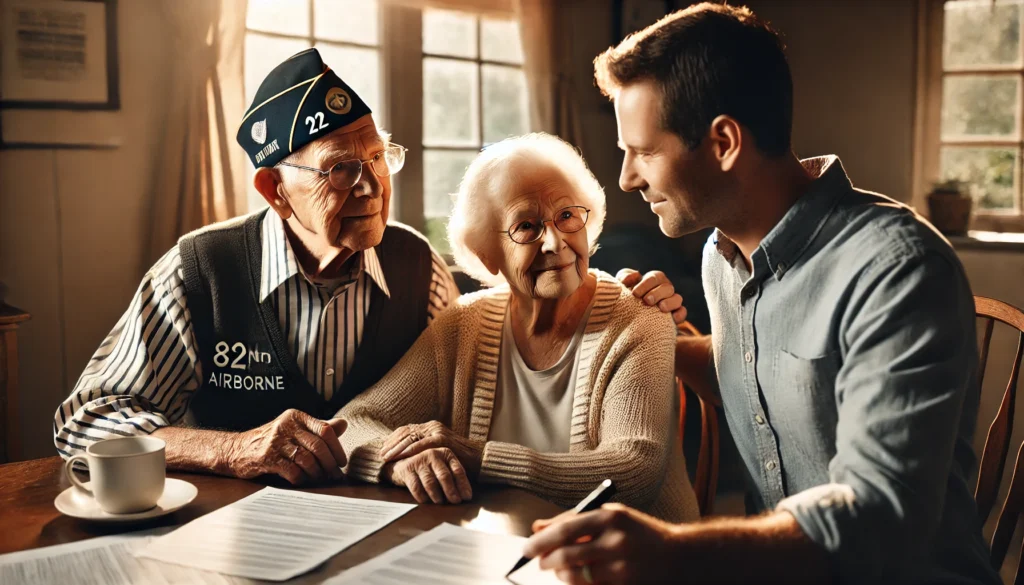Did you know? Nearly 1 in 3 families providing care for aging veterans report depleting their savings to cover medical and living costs. As Chester—who served in the 82nd Airborne at Normandy—approaches his nineties, his son-in-law Jim faces a critical decision: how to secure the best care for Chester without compromising the financial stability of Chester's 89-year-old wife, Sally. This case study takes you into Jim's journey, a story of duty, discovery, and transformation.
Imagine yourself in Jim's shoes. Your father-in-law, a hero of World War II, is now in his nineties, needing more care every day. Meanwhile, your mother-in-law Sally, though fiercely independent, is showing her own signs of aging. You want to protect her well-being, make sure Chester is well cared for, and preserve the dignity they both deserve. But with rising medical expenses and the complexity of Veterans Affairs (VA) benefits, what should be the next step?
Key Points
1. Veterans Benefits: A Lifeline Compared to Medicaid
VA benefits can provide a significant financial advantage over Medicaid for veterans like Chester. While Medicaid offers essential healthcare for those with limited income, it requires a near-complete depletion of assets before any support kicks in, and it can recover costs from the estate after the beneficiary’s death. By contrast, Veterans Health Administration (VHA) offers health services without imposing recovery liens, and Veterans Benefits Administration (VBA) pensions provide monthly financial support, aiding with medical and caregiving costs without forcing families into poverty.
2. Navigating Complexity: Eligibility and Expert Help
Jim’s challenge was figuring out whether Chester could qualify for VA benefits, given his wartime service in the 82nd Airborne. The eligibility requirements for VA’s Non-Service Connected (NSC) pension include age, disability, and a limit on net worth, currently capped at $155,356. Jim soon realized that understanding VA's look-back rule—preventing improper asset transfers—was critical. Seeking help from an elder law attorney helped Jim navigate these rules, ensuring that Chester qualified without risking penalty periods.
3. Weighing VA Benefits vs. Medicaid
Jim needed to decide between relying solely on VA benefits or turning to Medicaid to supplement care. The Veterans Health Administration (VHA) provided Chester with in-home health services—necessary since a recent fall had left Chester with mobility issues. The Aid and Attendance benefit from VBA added a crucial layer of support for caregiving costs, totaling more than $2,300 per month. In contrast, Medicaid's offering came with limitations: it could provide institutional care but would significantly erode Sally's financial future, as Medicaid would impose estate recovery once Chester passed away.
4. Protecting Sally’s Financial Security: The Role of Proactive Planning
One of Jim's most pressing concerns was ensuring that Sally, at 89, wouldn’t be left destitute if Chester’s needs exhausted their finances. By setting up a spousal protection trust, Jim preserved assets for Sally, shielding them from Medicaid’s estate recovery rules while allowing Chester to access VA benefits. Proactive planning, rather than waiting for a crisis, ensured that Sally retained a sense of financial security, even if her own care needs arose in the future.
Problem: The Complexity of Securing Benefits
Jim's journey began with confusion and doubt. Could Chester’s brief service, albeit during one of history’s most significant battles, qualify him for meaningful benefits? Would Sally lose her home if Chester’s health deteriorated further? The prospect of exhausting savings, selling off assets, and facing complex paperwork seemed overwhelming.
The emotional toll on Jim was immense. He had a strong sense of duty to both Chester, who had given so much for his country, and Sally, who deserved a stable and secure old age. The confusing and bureaucratic maze of benefits made him feel powerless at times, and the family was caught between an urgent need for action and a fear of making mistakes that could cost them dearly.
The Challenges of Aging in Place and Estate Planning
Aging in place is often the preferred choice for many seniors, but as Jim discovered, it comes with significant challenges. These challenges become even more complex when considering extended life expectancy and the associated costs of long-term care.
For Jim’s family, the choice to age in place required careful evaluation of home safety and the practicality of ongoing home care. As part of his proactive planning, Jim made essential modifications to his father-in-law’s home, such as installing handrails and reducing fall risks. The Aid and Attendance benefit provided a crucial supplement, making these modifications financially viable without draining retirement savings.
However, it’s important to note that aging in place is not always feasible or desirable, especially without the appropriate support structures. Jim ultimately had to consider assisted living options when his father-in-law’s health declined further. The financial assistance from the VA, combined with proactive planning measures, allowed for a smoother transition into assisted living without jeopardizing his mother-in-law’s financial stability.
Protecting the Estate for the Well Spouse
A central challenge for Jim was preserving his mother-in-law’s financial security after his father-in-law required increasingly expensive care. Unlike Medicaid, VA benefits such as the NSC pension and Aid and Attendance do not involve estate recovery rules, providing significant advantages for estate preservation.
To protect the family's assets, Jim worked with an elder law attorney to establish a spousal protection trust. This trust allowed assets to be preserved for his mother-in-law without disqualifying his father-in-law from receiving VA benefits or triggering Medicaid’s strict asset recovery process. The spousal protection trust enabled Jim’s father-in-law to access the care he needed while ensuring that his wife would not be left financially stranded if she required care in the future.
The High Cost of Inaction
When care needs escalate without a proactive plan, families often face limited options and increased stress. For Jim, delaying action could have resulted in having to rely on Medicaid, which, while providing essential care, would have forced his family into asset spend-downs and recovery rules that could have left his mother-in-law financially vulnerable. Medicaid requires recipients to exhaust almost all of their assets to qualify, and following the veteran’s death, states may pursue estate recovery for the care costs paid—effectively diminishing any financial security the surviving spouse might have.
The Case Design: Feasibility Assessment
Jim knew he needed help. He sought the expertise of an elder law attorney who specialized in veterans’ benefits. The attorney started by conducting a case design process, which involved assessing Chester’s eligibility for various benefits, analyzing their financial status, and understanding what care Chester required. The attorney confirmed that Chester’s service at Normandy qualified him for VA benefits, and because Chester was now over 65 and required help with daily activities, he was eligible for Aid and Attendance.
The feasibility assessment was about more than just eligibility. It was about ensuring that Chester and Sally could receive the help they needed without sacrificing everything they had worked for their entire lives. Jim came to realize that, through VA pensions, the family could receive substantial monthly assistance, helping to offset the rising costs of Chester’s care while protecting the estate for Sally.
Weighing Options: VBA, VHA, and Medicaid
With Chester’s eligibility confirmed, the next step was deciding on the best route for providing care. The Veterans Benefits Administration (VBA) and Veterans Health Administration (VHA) offered a two-pronged approach. VBA provided financial support through the NSC Pension and Aid and Attendance, offering monetary relief without forcing asset liquidation.
Veterans Benefits: A Superior Alternative to Medicaid
When Jim first explored options for his father-in-law, he was unsure about the sufficiency of his father-in-law's limited active service and turned to Medicaid as a potential fallback. However, it became clear that VA benefits offered unique advantages over Medicaid that would serve his family better in the long run.
The VA operates through two primary channels—the Veterans Health Administration (VHA) and the Veterans Benefits Administration (VBA). Understanding the difference between these branches and the benefits they provide is crucial for veterans and their families.
Veterans Health Administration (VHA)
The VHA delivers a range of health care services to eligible veterans, including comprehensive medical care, rehabilitation, and home health services. For Jim’s father-in-law, VHA benefits enabled him to receive in-home medical visits and necessary rehabilitation after a fall. Compared to Medicaid, which only offers health services to those with extremely limited income and mandates estate recovery upon the death of the recipient, VHA benefits provided both financial relief and peace of mind. There were no estate liens attached, meaning Jim’s father-in-law could access quality care without the concern of losing assets later.
Veterans Benefits Administration (VBA)
The VBA, on the other hand, provides financial benefits like pensions and compensation. In Jim’s case, his father-in-law qualified for a Non-Service Connected (NSC) Pension, which offered monthly support to help cover everyday expenses and care needs without any requirement for a service-related disability. The NSC Pension benefit was significant, allowing the family to avoid dipping into savings for essential care.
The Aid and Attendance benefit, an additional payment on top of the NSC pension, further helped cover costs associated with personal care, such as assistance with bathing, dressing, and meal preparation. This benefit proved invaluable as Jim's father-in-law's needs increased, ensuring his care needs were met while protecting the family’s financial stability.
Eligibility Requirements for VA Pensions
To qualify for the Non-Service Connected Pension, veterans must meet several key requirements:
- Wartime Service: Veterans must have served during a recognized wartime period, such as Jim’s father-in-law who served actively from 1958-1960.
- Age or Disability: Veterans must either be over 65 or have a permanent, non-service-related disability.
- Net Worth Limit: Currently, the net worth limit is $155,356, which includes all assets and income for the veteran and their dependents. To prevent asset manipulation, the VA also enforces a 3-year look-back period for any transfers made below market value.
- Medical Need: Veterans applying for Aid and Attendance must show a need for help with daily living activities.
On the healthcare side, VHA provided essential health services, from rehabilitation after Chester's fall to ongoing medical supervision. Medicaid, meanwhile, could cover certain long-term care expenses but at the cost of exhausting almost all the couple’s assets, making Sally’s future very uncertain.
Jim weighed the pros and cons. Choosing VHA and VBA benefits over Medicaid meant that Chester could continue receiving in-home care, which both he and Sally preferred. It also ensured that Sally's financial well-being was preserved. Jim realized that by avoiding Medicaid’s strict spend-down and estate recovery rules, Sally would not be left without resources if her own health declined.
Transformation: From Uncertainty to Peace of Mind
The transformation in Jim, Chester, and Sally’s story is profound. Jim went from feeling overwhelmed and powerless to a place of clarity and empowerment. With the right guidance, he was able to secure a comfortable, safe environment for Chester without risking Sally’s security. Chester moved from a place of physical pain and uncertainty to one of safety and peace, receiving the care he needed in his own home. Sally, meanwhile, gained reassurance that her financial security remained intact.
Jim’s increased status within the family was evident. He had navigated the complex system of benefits, made informed decisions, and taken action to honor Chester's legacy while ensuring Sally’s dignity. This journey is not just about accessing benefits—it’s about empowerment, protection, and legacy. Jim became a hero in his own right, not on a battlefield, but in the arena of family care and legacy protection.
Conclusion: The Importance of Proactive Planning
Chester’s story, as managed by Jim, highlights the immense value of proactive planning. Veterans’ benefits are an often-underutilized resource that can transform the quality of life for aging veterans and their families. By understanding the difference between VA benefits and Medicaid, recognizing the importance of expert help, and taking proactive steps to protect assets, families can avoid financial devastation and ensure dignity in aging.
If you find yourself in a similar position as Jim, take action today. Start by understanding your eligibility, consult a professional to navigate the complexities, and make the choice that preserves both the care needs of your loved ones and the financial stability of their surviving spouse. The cost of inaction is too high, but with the right planning, the path forward is one of dignity, honor, and peace.




